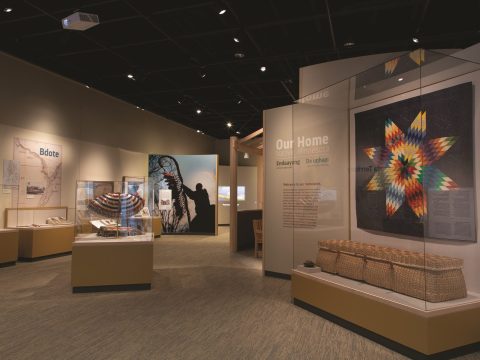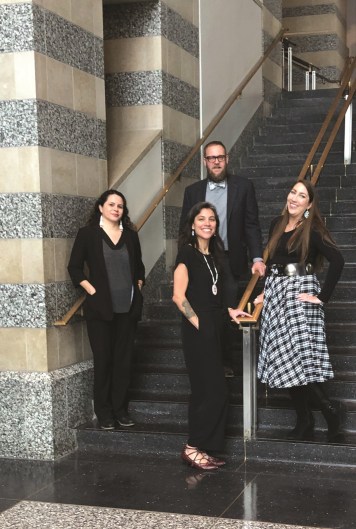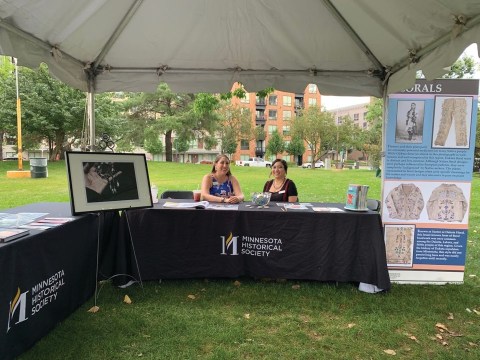
This article originally appeared in the May/June 2021 issue of Museum magazine, a benefit of AAM membership.

The Minnesota Historical Society created a department to implement a strategy for Native American programs and services.
Mni Sota, the Land Where the Waters Reflect the Sky in the Dakota language, has always been, and will forever remain, an Indigenous place. Today, more broadly known as the state of Minnesota, these lands hold the memory of Dakota origin, as this is where Dakota people, the eastern bands of the Oceti Sakowin (Seven Council Fires also known as the Lakota, Nakota, and Dakota people), came into being.
This is a significant place in the migration story of Ojibwe people, and over the years it has historically been, and continues to be, home to Native American people from many tribal nations and backgrounds. Currently, 11 Dakota and Ojibwe tribal nations have lands in Minnesota, retained over time through treaty-making, in spite of removal, and most importantly through resilience.
Indeed, we carry this resilience with us as we navigate through the experiences of being Native and working within the walls of a deeply embedded colonial system such as the Minnesota Historical Society (MNHS), particularly since for many years this organization was telling our stories for us rather than with us. Working at MNHS can be an isolating and lonely experience due to the ongoing impacts on our communities caused by past actions of this institution and those who founded it. In order to commit to efforts of reckoning and inclusion within these colonial spaces, we have learned that a team approach, rather than a single position for engagement, is imperative.
MNHS was founded in 1849, nine years before Minnesota became a state. Like other museums during this time period, MNHS prioritized the collecting of Indigenous material culture while mythologizing the peoples and societies to whom these items belonged. These collecting practices supported archaeological projects that oftentimes included the excavation and collecting of human remains. The agenda of the time was to record evidence of our existence, with the expectation that we as Indigenous peoples would not survive colonization.
These initiatives continued well into the 20th century, contributing to the vast collections of Native American history at this institution. Over the years, MNHS has revised its collecting practices but continues to hold items of cultural significance to Native nations that could and should be returned to tribes. MNHS and other museums must initiate systemic change to remove historic barriers to, and better support, repatriation efforts. Though difficult work, these efforts are necessary.
Acknowledging past (and often ongoing) harm, MNHS is now focusing on developing and building sustainable relationships with Native American communities, diversifying staff, and working to support public education on Native American histories throughout the state and region. We as Indigenous peoples must tell our own stories, and it is important to empower multiple community voices and perspectives so that we can share these stories more often and more authentically.
Indigenizing the Field
In 2016, MNHS created the department of Native American Initiatives (NAI) to help develop and implement a vision and strategy for Native American programs and services. The first of its kind at MNHS, and quite possibly in the country, the NAI department seeks to work in collaboration with Native Nations and community members throughout the region.
This broader focus is important because for Native peoples, these state borders are not ours; they were imposed on us. We must remember and honor all Indigenous to Mni Sota, including our Dakota relatives who were removed by policy from the state after going to war with the United States government in 1862. Though we are a team of four, the NAI is growing, and our director sits on the leadership team of MNHS, reporting directly to Director and CEO Kent Whitworth.
Our team has incorporated Indigenous worldviews throughout our work, and we have navigated a path for Native inclusion within a large colonial institution not originally created to serve us. By implementing strategies for community collaboration and cross-departmental teamwork, we have strengthened partnerships, and we look to the future with a clear vision of where we fit and belong as Indigenous peoples within this institution.

The NAI department works closely with the Indian Advisory Committee (IAC), which has provided input and guidance on MNHS activities and initiatives related to Minnesota and Native American history for more than 30 years. The IAC is made up of tribally appointed representatives from each of Minnesota’s 11 federally recognized tribes and at-large members from Native communities.
One of the department’s first initiatives was the creation of a Dakota Community Council (DCC) in 2017, known as a wi’wahokichiyapi, or partnership, made up of Dakota members from Minnesota and surrounding states. The DCC’s objective is to ensure that Dakota people, history, perspectives, and homelands are honored at MNHS as well as at the historic sites within an area defined by the first treaty between the United States and the Dakota people in 1805.
The DCC and other stakeholder groups are collaborating with MNHS on the revitalization of Historic Fort Snelling, which includes restoring the landscape to include Indigenous plants and medicines, renovating two historic buildings into a visitor center and orientation space, and presenting a new interpretive plan that tells the many complex histories of the area. Historic Fort Snelling is located at Bdote near the confluence of the Minnesota and Mississippi rivers, which is a sacred site of creation for Dakota people.
These partnerships speak to the importance of engaging with sovereign nations in a reciprocal approach that puts the needs of the communities first.
Institutional Work
To be more inclusive of Native American people and tribal nations, and authentically engage with Native communities, MNHS must acknowledge the role it has played in helping to create a state narrative that actively excluded Indigenous peoples and perspectives.
A cross-departmental team is currently developing a framework for an Institutional Acknowledgment that includes a public statement, to be displayed at our historic sites, as well as a researched and reviewed historical report of the complicated relationship between the institution and Native American peoples past and present. This work is in progress, with a phased rollout planned over the next year.
Additionally, we are actively attempting to draw Native people into our work through experiential learning opportunities where their perspectives and voices are critical. In 2018, MNHS received a grant from the Andrew W. Mellon Foundation to support its commitment to increase Native representation within the museum field. Drawing on the programmatic themes of a previous MNHS fellowship, the Native American Undergraduate Museum Fellowship Program seeks to engage undergraduates in professional opportunities within the museum and cultural resource, public history, and tribal historic preservation fields. Fellows learn about various career and academic paths in these types of organizations as well as the particular challenges faced by American Indian communities related to preserving tribal history. We consider this an essential component of Indigenizing the field.

Meeting a Long-Awaited Need
As one of the largest historical societies in the country, MNHS has long been known as a place where Minnesotans can learn about their histories—although it has mostly focused on the settler colonial history. Our journey as an institution has been heavily involved in the silencing and erasure of not only Native histories and voices, but the voices of BIPOC and marginalized communities as well. Over the years, the institution has faced and addressed criticism on this issue.
In the past decade, interest from the public to learn about, and from, Indigenous peoples who reside within Minnesota has increased dramatically. This is due in large part to a change in the state academic standards in social studies that created several new benchmarks within K–12 education related to Minnesota’s Indigenous history.
Led by a content team composed primarily of Native staff, and in consultation with Native community educators, MNHS created the “Our Home: Native Minnesota” exhibition gallery, which opened in December 2019. “Our Home” is helping to change the narrative that is so often told about Indigenous peoples in our state. The 11 tribal nations that share space with the state of Minnesota are highlighted in the exhibition through stories provided by Native voices and supported by material culture, maps, books, and photographs from the museum’s collections. The languages of Dakota and Ojibwe peoples are seen throughout the panels, taking priority over English. Each section in “Our Home” has its own feel, not following any timeline, but sharing experiences from the past and present. Voices of our youth can be heard as part of a learning interactive on place names, helping others better understand the deep meaning of place to Native American peoples.
MNHS’ commitment to “Our Home” also includes many opportunities to further engage not only the general public, but also the Native community, specifically by working with Native professionals. MNHS hired interpreters from the Native community to better engage with other interpretive staff and the public. To strengthen our interdepartmental collaboration, we worked with the MNHS Teacher Education team to develop a curriculum covering the many subjects presented within the exhibition. The curriculum was reviewed and vetted by community partners and Native educators.
An additional rotating gallery space is connected to the larger exhibition and is designated for community partnerships. Though delayed due to the pandemic, an exhibition on traditional Indigenous games in Minnesota will soon be developed for this space in collaboration with Native community members and organizations.
Programming continues virtually as we navigate through the pandemic, making it easier to reach some Native communities that have difficulty making the trip to St. Paul. Now that “Our Home” is a permanent exhibition at the History Center, we will continue to use it to share Dakota, Ojibwe, and other Indigenous histories through a variety of programs.
Empowering Our Colleagues and Building Sustainable Change
In order to successfully engage with Indigenous communities outside of the institution, we as Native professionals within MNHS feel it is imperative that we:
- see ourselves represented as an integrated team within the workforce and leadership of the institution;
- have a dedicated space where we can help to educate and serve as a resource internally as well as externally; and
- hold the institution accountable for historic, contemporary, and ongoing impacts to Native communities.
We must always serve as advocates for our communities while working at MNHS. This is not an easy task, nor do we take this work lightly. We work for our communities with and at MNHS. We are focused on eliminating barriers and paving the way for sustainable institutional changes that will outlive our professional tenures at MNHS. This community-centered, collaborative, and forward-thinking approach is part of an Indigenous strategy rooted in our Indigenous tribal traditions.
While NAI may be a small team, we are working with our Department of Inclusion and Community Engagement and our Chief Inclusion Officer in advocating for more BIPOC representation across the institution. We continue to build strong relationships with our non-Indigenous colleagues and are modeling effective cross-departmental relationships, promoting allyship, and building capacity by encouraging collaborative projects and advocating for community partnerships.
While we haven’t yet been able to reach all tribal communities in our region, we are building a strong foundation for future collaborations, and we continue to see progress as we remain committed to Indigenizing the field. We have learned that actionable opportunities follow the first step of land acknowledgements, and we encourage other institutions to follow our approach to this work: ensure you have strong relationships with Native nations, and follow the lead of Tribal Historic Preservation Officers and other Native leaders, educators, and organizations in your region.
Always ask yourself, “Are Native people visible in the work that we do?” If not, work hard to include Native perspectives and integrate rather than tokenize peoples and histories.
Kate Beane, Ph.D., (Flandreau Santee Sioux) is director of Native American Initiatives, Amber Annis (Cheyenne River Lakota) is a program and outreach manager in Native American Initiatives, and Rita Walaszek Arndt (White Earth Ojibwe) is a collections specialist in Native American Initiatives at the Minnesota Historical Society in St. Paul.








Comments